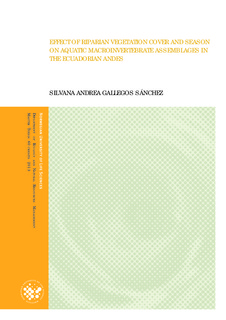| dc.contributor.author | Gallegos-Sánchez, Silvana Andrea | |
| dc.date.accessioned | 2013-08-12T10:31:53Z | |
| dc.date.copyright | 2013 | |
| dc.date.issued | 2013-08-12 | |
| dc.identifier.uri | http://hdl.handle.net/11250/187119 | |
| dc.description.abstract | The purpose of this study was to investigate the effects of season and changes in the riparian vegetation cover on diversity, structure, temporal variability, and trophic structure of aquatic macroinvertebrate assemblage in the Sambache River, Pasochoa Wildlife Refuge, Ecuador. Macroinvertebrate samples were collected using a Surber bottom sampler during the dry and rainy seasons from sections of the river dissecting three different riparian vegetation types with varying degrees of disturbance: 1) Humid montane forest, 2) Secondary forest near maturity and 3) Disturbed forest with shrubs and pastures. A select set of environmental variables were collected from the same sites. Results show that the Sambache River macroinvertebrate fauna is mainly composed of aquatic insect represented by three orders: Diptera, Ephemeroptera and Trichoptera. Important differences in abundance of several genera were found between the three riparian vegetation types and seasons. Andesiops and Atopsyche were more abundant in the dry season in sections of the river from humid montane forest sites. Probezzia increased its abundance during the rainy season in the three riparian vegetation types. Using a Canonical Correspondence Analysis to assess the effect of environmental variables on aquatic macroinvertebrate assemblages, I found that conductivity and amount of total dissolved solids were the most important parameters explaining macroinvertebrate assemblage structure. Regression analysis showed that genera richness and diversity were influenced by flow velocity, and that the most abundant genera in this study were controlled by a combination of different environmental variables. Trophic guilds were dominated by the collector-gatherers in all section of the river across the two seasons. Predators increased during the rainy season, possibly related to an increased abundance of food resources. This study provides further information on the distribution of macroinvertebrate taxa in the Ecuadorian Andes and their relationship with environmental factors. The study suggests that riparian vegetation may affect assemblage structure and that current land-use change in the region is affecting the composition of the aquatic fauna. I recommend that environmental variables and macroinvertebrates in the Sambache River should be monitored long term to establish better management strategies to protect the watershed and its ecosystem services. | no_NO |
| dc.description.sponsorship | Norwegian University of Life Sciences and National Secretary of Higher Education, Sciences, Technology and Innovation of Ecuador (SENESCYT) | no_NO |
| dc.language.iso | eng | no_NO |
| dc.publisher | Norwegian University of Life Sciences, Ås | |
| dc.subject | Andes | no_NO |
| dc.subject | aquatic macroinvertebrates assemblages | no_NO |
| dc.subject | Pasochoa | no_NO |
| dc.subject | environmental variables | no_NO |
| dc.subject | Ecuador | no_NO |
| dc.subject | Sambache | no_NO |
| dc.title | Effect of riparian vegetation cover and season on aquatic macroinvertebrate assemblages in the Ecuadorian Andes | no_NO |
| dc.type | Master thesis | no_NO |
| dc.subject.nsi | VDP::Mathematics and natural science: 400::Zoology and botany: 480::Ecology: 488 | no_NO |
| dc.description.embargo | 2014-07-30 | |
| dc.source.pagenumber | 37 | no_NO |
